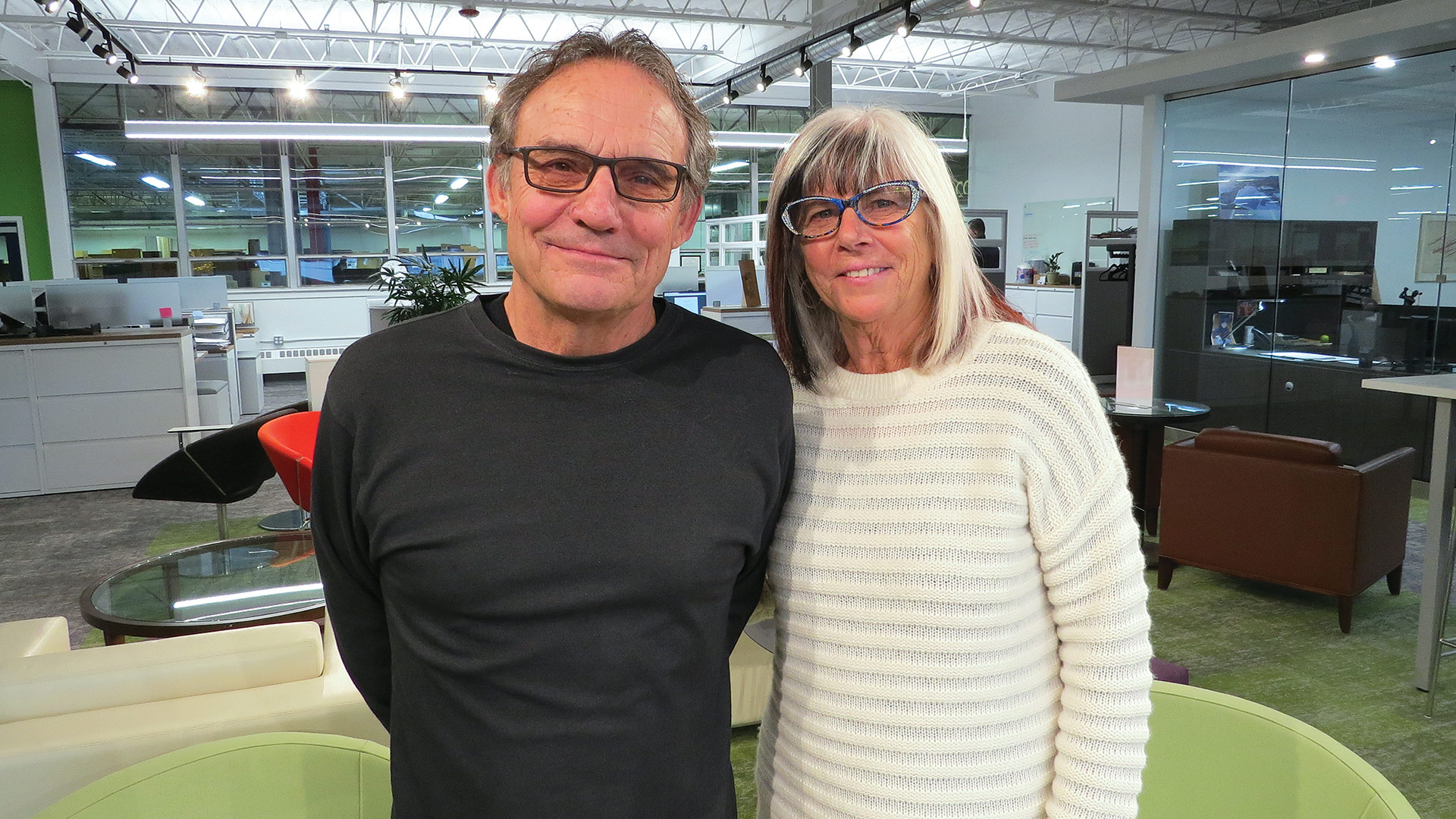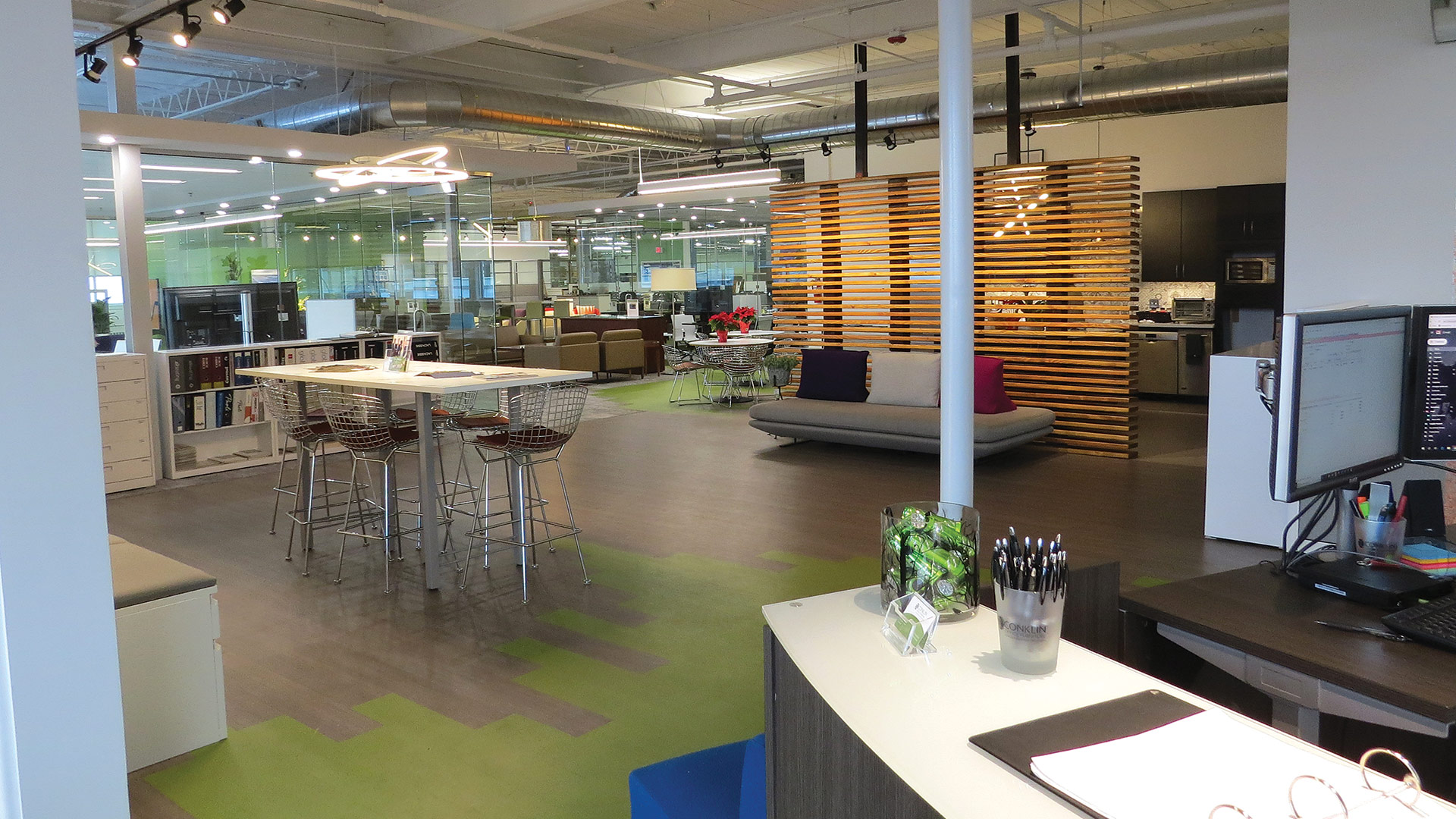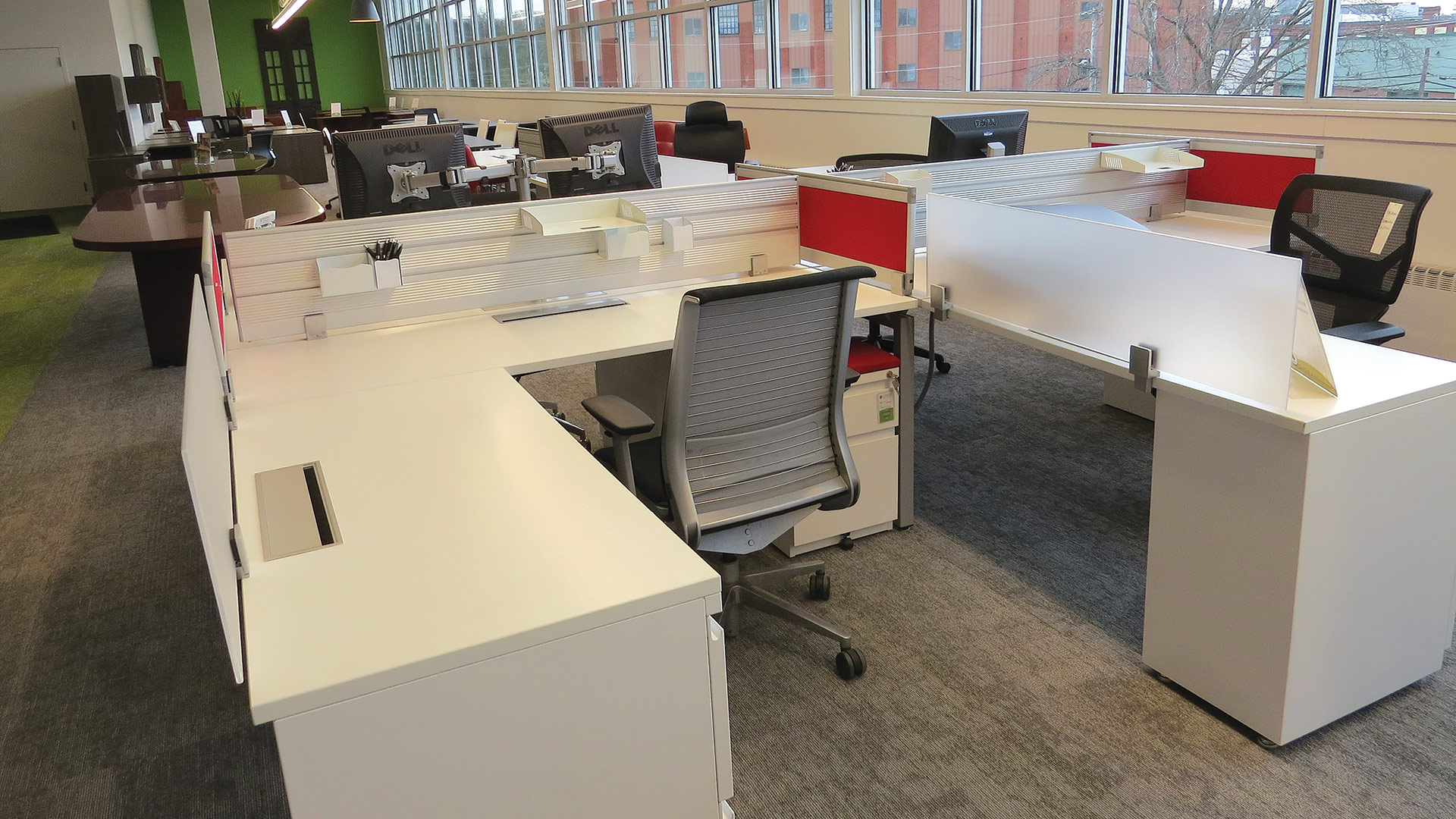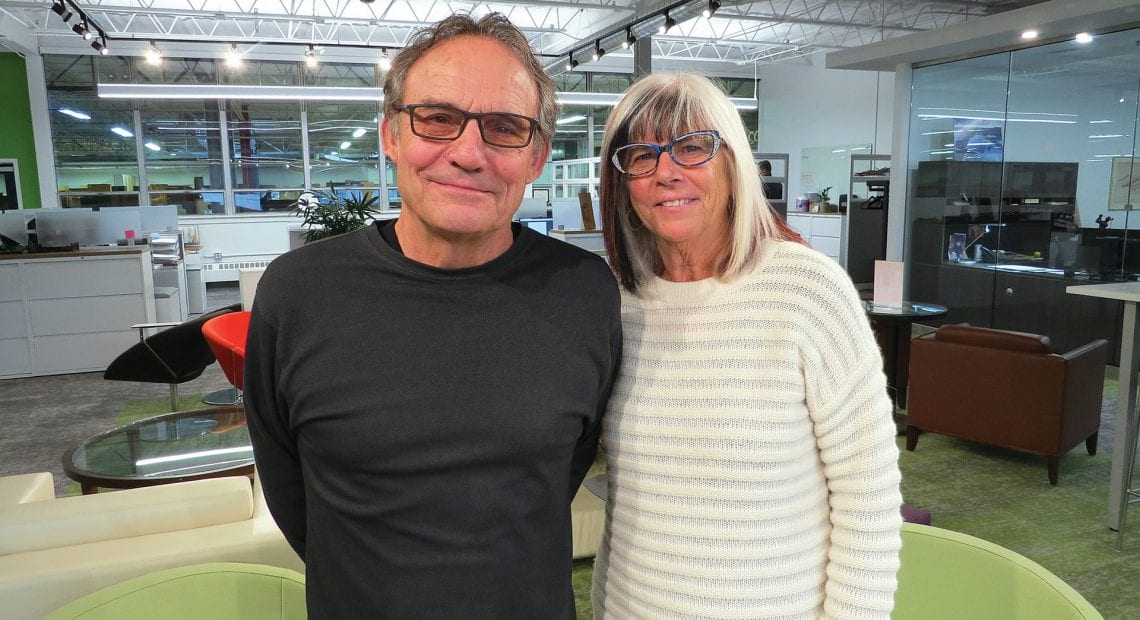All the Right Moves

Fran Arnold and his wife, Rosemary, have guided the family business through consistent growth and evolution over the past four decades.
Conklin Office recently completed the consolidation of its various operations into the former Ampad factory on Appleton Street in Holyoke. The new space tells a story about how this company has evolved over the years — and also about the modern office and what it should look like.
The back wall of the massive showroom at Conklin Office Furniture’s complex on Appleton Street in Holyoke is decorated in a somewhat unorthodox but quite meaningful way.
There, Fran Arnold, owner and president of this multi-faceted, family-run operation, has arranged some of the signs that have hung on the company’s facilities over the years, including one from when he bought the venture in 1981; it says ‘Conklin Office & School Supply Company.’
“I kept them — and I thought this would be good place for them,” said Arnold as he offered a tour of the sprawling facility. “They tell a story, really — they tell how far we’ve come over all these years.”
Indeed, they do.
The ‘Office & School Supplies’ part of the operation was scrapped a long time ago as Staples and businesses like it took over that part of the world. And the ‘office’ part of the equation has evolved tremendously into a company with a host of moving parts — from sales of new and mostly used furniture (including lines the company has developed itself) to recycling and reconditioning of furniture of all kinds, to an office-design component.
It’s all under one roof now — one very large roof — after the company moved its showroom and offices from a facility on Canal Street (sold to one of the many entities now looking to cultivate cannabis in Holyoke’s vast portfolio of old paper and textile mills) last fall. It was quite a move, as one can imagine, and the company is in many ways still catching its breath after that lengthy and logistically complex undertaking.
“We decided to do it like a Band-Aid; we just pulled it off quickly,” he said, noting that the move came in one large stage that ended in October rather than several, and the moving-in process is still ongoing in some respects.
But the new space seems to be well worth all the cost and trouble. And it gives the company an opportunity to not only display all that it sells, but also put the modern office — or the emerging interpretation of the modern office — on full display.
“I don’t think the ink on the contract was dry when Staples opened up. That put such pressure on all the old, local office-supply dealers that many of them went of business. I took a turn toward used office furniture.”
Indeed, the office/welcome area at Conklin employs many of the current trends, said Arnold, from the glass walls that surround his own office to the wide-open spaces, distinct lack of cubicle walls, modern lighting, and sit-stand desks being used by employees.
Meanwhile, the items on the floor, especially new benching models and smaller workstations, speak to how businesses are maximizing the square footage they’re willing to pay for.

The signs on the back wall of the new showroom help tell how far this business has come over the years.
“Everything is moving toward efficiency and budget,” he explained. “The individual workspace is getting smaller, but that’s necessary — office space in New York and these other major cities costs a fortune today, so companies are reducing the size of the footprint the person sits in, but the spaces are open and more conducive to collaboration.”
Conklin’s product lines, and its own offices, speak to these trends, said Arnold, adding that, while the company responds to these movements, it is also living up to the motto seen on many of those aforementioned signs: “What Goes Around Comes Around.”
That’s a nod (and a play on words) to the recycling and re-manufacturing aspects of the business — huge components of the operation — but also to its very ‘green’ mindset (right down to the 2,600 solar panels on the roof) and the way the company does business with a wide range of businesses in sectors ranging from education to financial services to manufacturing.
For this issue, BusinessWest visited the Conklin complex in Holyoke and talked with Arnold about office furniture, the modern office and how it continues to evolve, that motto and all that it reflects, and those signs along the wall in the showroom and how they really do tell a compelling story.
News Desks
While office design and office furniture are obviously serious businesses, Arnold said it’s quite OK — and actually quite necessary, in his mind — to have a little fun with it all.
Hence the names on many of the chairs he showed BusinessWest in one of the showrooms.
There’s the ‘Nellie,’ named after one of his granddaughters; the ‘Roxie,’ named after Conklin’s office manager; the ‘Brode,’ named after one of his grandsons; and the ‘Vito,’ named after … him; that’s what his grandkids call him. There’s also the ‘Junior Vito,’ a slightly smaller version of the original.

Conklin’s new facilities were designed to reflect the changes that have come to the modern office.
These chairs, all on the cutting edge of ergonomic trends, are part of the Gateway line of furniture the Conklin company has developed itself. The products — everything from chairs to benching to laminate furniture — are made in China, said Arnold, and they’re selling well as companies large and small look for value, quality, and chairs that are ergonomically friendly.
‘Fun’ isn’t a word that word that would be used to describe Conklin’s recent move — Arnold shook his head as he thought back on all that was involved — but it was necessary in some ways, and now that it’s over, the company is in a better place than it was — figuratively but also quite literally.
Arnold was able to take advantage of the soaring interest in Holyoke real estate, and the company, as noted, is now able to put everything together under one roof.
And as the tour clearly showed, it is a huge roof, and there is a lot under it.
The many components have come together over the past 39 and a half years, and there has been constant evolution, said Arnold, noting that, as that sign said, the Conklin company he bought in 1980 sold office supplies.
“I don’t think the ink on the contract was dry when Staples opened up,” he recalled. “That put such pressure on all the old, local office-supply dealers that many of them went of business. I took a turn toward used office furniture.”

And that has been the company’s main focus for most of its existence — buying and reselling used furniture, often refinishing, refurbishing, or ‘remanufacturing’ it (the term the company prefers to use) before it lands in the showroom or the warehouse. This mindset is captured succinctly in another one of those old signs hanging on the back wall: Beside the company name and logo, it reads ‘Don’t Monkey Around with the High Cost of New Office Furniture.’
Companies of all shapes and sizes have heeded that advice, and Conklin has taken full advantage, growing into one of the largest operations of its kind, with other offices in Red Bank, N.J., Philadelphia, and Chicago.
The company’s showrooms are filled with furniture bought across the country from a variety of sources. Very often, it arrives via liquidations — large companies either closing or moving from one space to another and selling the furniture it leaves behind.
“You can’t move more than 100 people over a weekend and move the furniture at the same time,” Arnold explained. “They need to move into furniture that was already set up.”
The Conklin company spent the ’80s and a good part of the ’90s building up the vast amounts of capital needed to properly run a business like this one and expanding operations. The company was located on Lyman Street in Springfield for a number of years, and also operated out of property on Warwick Street.
“You used to be able to put 100 8-by-8 cubicles on a floor; today, you can put 250 people on that floor. And what the employees are getting back by having so little space are big open areas.”
In 2005, Conklin moved its headquarters to the massive facility on Canal Street that was formerly home to American Thread and one of the first factory buildings built in Holyoke, and later moved the showroom (still on Lyman Street) there as well.
“We never thought we’d fill up Canal Street, but we did,” he Arnold went on, adding that the company eventually needed additional space and found it, ironically enough at the former Ampad facility on Appleton Street (Ampad made the legal pads and other office products the Conklin company once sold), which it purchased in 2008.
And in that 233,000-square-foot facility, the company greatly expanded its reconditioning and remanufacturing operations, adding a powder-coating operation, reupholstering, and more. Eventually, it was decided that operations needed to be moved there as well.
“I thought that the building on Canal Street was not really conducive to what we do,” he said. “We need higher ceilings and big areas to move in, and I started thinking about selling Canal Steet.”
Those thoughts coincided with the start of the cannabis era in Massachusetts and broad interest in Holyoke’s old mills for a number of possible reuses — cannabis in particular, but also condominiums and apartments.
“There were two or three serious possibilities in play working with condominiums or apartments,” he recalled. “But, lo and behold, cannabis was legalized, and they came after the building.”
‘They’ is True Leaf, a Florida-based medical-marijuana dispensary, he went on, adding that things moved quickly after that, with Conklin having to move out 150,000 square feet of space cram-packed with furniture.
Space Exploration
And eventually move it into space Arnold described as “totally raw” and, like much of the used furniture that comes his way, in need of some refurbishing. His staff now occupies the former administration area of the Ampad operation, space that looked like offices used to look, with enclosed private offices against the windows and tall cubicle walls outside — “people really couldn’t see much further than eight or 10 feet away from where they were.”
That has all been replaced with what most are saying the modern office should look like, said Arnold, who, as he talked about trends in modern office furniture and design, abruptly stopped talking and started walking toward a showroom area at the front of the store where the ‘Roxie’ and ‘Nellie’ are on display.
Talking again as he walked, he said offices everywhere, but especially those in large cities where real-estate prices are soaring, are getting smaller, and every square foot is being put to efficient, meaningful use.

Many people are doing some work at home, he went on, and companies are encouraging more people to join those ranks. For those who do come to the office, their employers are seemingly in a mood to trade more of those aforementioned wide-open spaces for smaller actual workspaces.
“You used to be able to put 100 8-by-8 cubicles on a floor; today, you can put 250 people on that floor,” he said. “And what the employees are getting back by having so little space are big open areas to continue their productivity — areas for collaboration, coffee bars, and just communal areas where they can be themselves. And windows are being left open, so they can see what’s going on outside.”
To get this point across, he referenced a product the company is selling a lot of these days — benching. These are small workstations — a desk with a drawer or two underneath — arranged in rows, or benches, with fabric screens separating the workers on either side of these benches.
While some of these workspaces measure 30” by 72”, said Arnold, many companies have moved to 60” and others to 54” or even 48”. The goal, as he said, is to put more people into a smaller amount of space, knowing they only spend some of their time at these spaces, with the rest in those collaborative areas mentioned earlier.
The Conklin website now lists a number of benching options, many part of what it calls its Stretch line, as well as what would be considered today’s ‘private’ office — a desk (often one that can be raised or lowered), credenza, and pedestal, all of them small in comparison to what was popular years ago.
And while staying at the forefront of these trends, with its Gateway line and items on the showroom floor, Conklin is working hard to respect that motto and be ‘green’ in every way it can — from the solar panels, which produce enough power for roughly 125 homes, to every aspect of the recycling operations.
“When we take a [cubicle] panel apart, all the fabric gets sent down south; it gets ground up and recycled,” Arnold said. “The shrink wrap gets baled and sent to a local company that makes oil from it. All the cardboard is baled … very, very little goes to the landfill.
“We’ve been ‘green’ from the very beginning,” he went on. “It’s a big part of who we are.”
Chair Man
As he walked around the office area at the new headquarters building, Arnold noted that all it might be missing, that’s might, is a large aquarium — a touch he might look to add in the near future.
Other than that, it represents all that the modern office is — or should be — in terms of space, light, glass, work areas, amenities for employees, and space-saving strategies for employers.
It also represents change and evolution for this company, which has come a long way since it sold office and school supplies on Lyman Street.
Like Arnold said, those signs on the showroom wall tell a story — one of ongoing growth, evolution, being ‘green,’ being proactive, and introducing products like the ‘Vito’ and the ‘Junior Vito.’
A story with a number of intriguing chapters still to be written.
George O’Brien can be reached at [email protected]


















